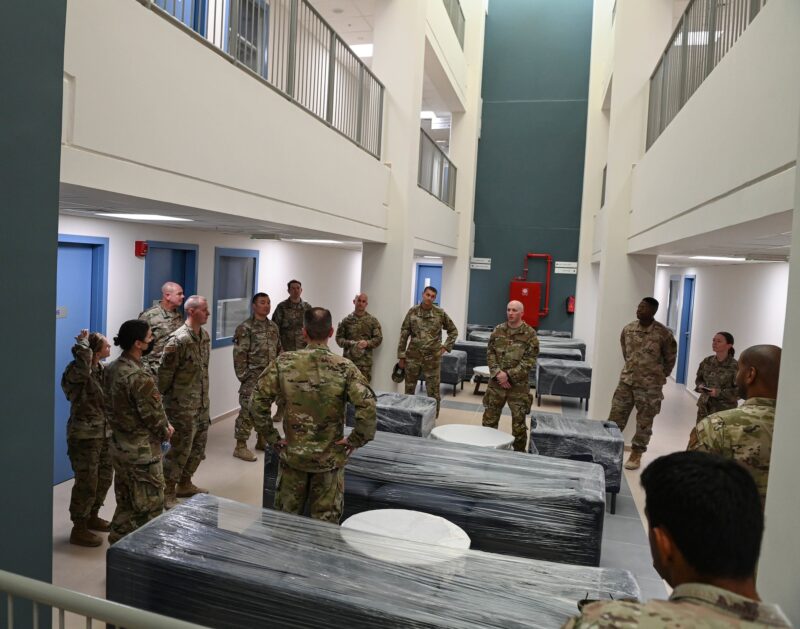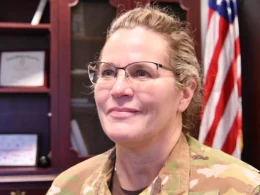JOINT BASE SAN ANTONIO-LACKLAND, Texas – The Air Force Installation and Mission Support Center is putting more than $1.6 billion in infrastructure funding to work to improve unaccompanied housing and child development centers across the Department of the Air Force.
Overall, the Air Force Civil Engineer Center, one of AFIMSC’s primary units, is planning to execute construction efforts at more than 61 installations between FY23-FY27, including:
- An AFCEC-led “Dorm Response Program” initiative to fund 170 permanent party dormitory projects through 2027. The pilot program prioritizes large, full-depth, renovations and design projects to create spaces for Airmen and Guardians. Currently, four dorm projects valued at more than $76 million are in design
- Funding $227 million for 14 large-scale dorm renovation projects in FY24. Of those, AFCEC will oversee the design and construction of five of dorms at JBSA-Lackland, Travis AFB, California, and Vance AFB, Oklahoma
- 19 new CDCs in planning and design to help increase capacity between FY22-FY27. Programmed at $205 million, the priority projects include new CDCs at Joint Base San Antonio and Sheppard Air Force Base, Texas; Scott Air Force Base, Illinois; and Wright-Patterson Air Force Base, Ohio
- Five CDC awards programmed for $167 million between FY23-FY24
“The Air Force fights from its bases, which means resilient infrastructure is important to mission readiness but also is taking care of Airmen executing the mission,” said Tim Sullivan, interim built infrastructure executive director and facility engineering directorate chief at AFCEC. “We couldn’t do the mission without them and ensuring we provide quality living conditions is of the utmost importance to us.”
In 2022, Congress mandated an investment increase for quality-of-life focused infrastructure, prioritizing improvements to unaccompanied housing, or dorms, for Airmen and Guardians. Under the National Defense Authorization Act requirement, DAF is planning to spend an average of $220 million each year through FY26 on this effort.
A year earlier, AFIMSC took its own steps to focus resources on dorms and CDCs by setting up a Quality-of-Life Investment Focus Fund. Recognizing the criticality of these facilities as a quality-of-life initiative, AFIMSC is committed to investing $300 million per year through FY26.
“We’re prioritizing restoration and modernization to deliver state-of-the-art facilities through these funds so Airmen and Guardians can focus on keeping the mission in flight, knowing they and their families are being taken care of,” Sullivan said.
The investment commitment puts Guardians, Airmen and their families first to fulfill DAF’s commitment to improve and sustain quality-of-life and well-being living standards for service members and their families.
“We’ll continue to make wise investments to upgrade infrastructure to ensure longer dorm facility life and less annual maintenance costs,” said Marc Minneci, Dorms Activity Management Plan Enterprise Program manager at AFIMSC’s Installations Support Directorate. “Whether it’s repairing an entire building structure or replacing outdated equipment or furniture these investments will improve living conditions for enlisted Airmen and Guardians.”
Minneci and his team are in charge of developing a facility dorm master plan and an investment strategy for over 900 dorms to support the Air Force dorm portfolio, worth more than $20 billion.
With FY23 in motion, we are well positioned to meet the DAF’s investment objectives, Sullivan said.
Working closely with bases worldwide, AFIMSC is providing support and resources while AFCEC is leading wide-ranging construction efforts through its facility sustainment, restoration and modernization, and military construction programs.
For example, at Travis AFB, AFCEC is going to renovate a couple of dorms and develop a plan for a new CDC.
“We have full confidence in partnering with AFCEC because they provide the unique expertise and long-term continuity needed to manage the projects here at Travis,“ said David Lin, deputy base civil engineer at the California base. “They understand and have the vested interest that they are not just renovating rooms of just any old building but are positively impacting where our young Airmen live and call home.”
In Alaska, AFCEC, in partnership with AFIMSC’s Detachment 2 and the U.S. Army Corps of Engineers, recently awarded a $67 million construction effort for a new dormitory at Clear Space Force Station. The state-of-the-art facility will provide quality accommodation for 84 noncommissioned officers and senior NCOs, and includes common-use areas like multi-purpose day rooms and laundry rooms.
“Funding for these quality-of-life programs will accelerate delivery of safe and modern places Airmen and Guardians can thrive in, in addition to improving access to child-care programs,” said Col. George Nichols, deputy director for AFCEC’s Facility Engineering Directorate. “We’ll be able to move ahead with a lot of improvements to provide affordable child-care facilities and the comfortable dwellings warfigthers can call home.”
Through AFIMSC’s unity of effort practice, AFCEC partners with the Air Force Services Center to deliver critical child-care needs for the enterprise that meet all of the necessary requirements. AFCEC provides design and construction expertise while AFSVC leads the programming part, designing child and youth programs that build resilient families.
“Giving Air and Space Forces families access to affordable child care is an essential part of military service, especially given the work our nation asks of them. These quality-of-life investments are critical,” said Col. Carolyn Ammons, AFSVC commander. “By working with our AFIMSC teammates in civil engineering and finance, we’re able to build more facilities to deliver the quality care our military families deserve.”
The UoE partnership is critical to align the planning, programming and execution of MILCON and FSRM programs to meet the DAF’s objectives. By joining forces, experts in AFIMSC’s Installation Support Directorate and AFCEC’s Planning & Integration Directorate prioritize project requirements in line with the DAF’s Infrastructure Investment priorities for the centralized funding.
AFIMSC is managing the centralized FSRM funds through the Air Force Comprehensive Asset Management Plan, or AFCAMP, process.
AFCEC established AFCAMP to evaluate FSRM requirements across the Air Force which enables the planning and prioritizing of FSRM projects in a five-year outlook, targeting installation critical mission needs across the enterprise.
“We all have different milestones, but all need to be on the same page to understand the right prioritization and ensure all our timelines are set to meet the funding goals,” said Danielle Poyant, AFCAMP integrator at AFCEC.










